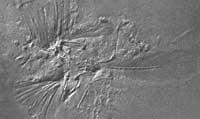Is there a relationship between evolution and destruction?
1995/02/01 Nuñez-Betelu, Koldo Iturria: Elhuyar aldizkaria
From the Darwinian point of view, competition is not only a necessary condition for evolution, but also the main cause of extinctions. Darwin explained evolution as: “Each new species arises and endures from advantages over others competing with it, which is the essence of natural selection.
Consequently, the disadvantages are destroyed.” If so, the frequency of extinctions would be very constant, but the fossil record shows the opposite, that the frequency is very variable. Although the destructions are constant, at certain times of geological time they have been very abundant and are called “mass destruction”.
Darwin himself acknowledged that there were massive destructions and exposed them as gaps in the fossil record. But the sporadic character of mass extinctions shows that the role of non-biotic factors is more important than that of Darwinian models. Therefore, progesive exclusion through competition and resulting extinctions are not frequent. But does the window have to do with evolution? Yes. Intrinsic competence is the main characteristic of evolution through natural selection and the “struggle for life” is the adaptability of living beings.
On the other hand, there is an interspecific competence that can alter the characters of similar species that inhabit the same area. However, speciation and adaptation divergence are two different aspects of adaptation radiation and their relationship is very complex. In the Darwindar model, both were united in a single concept, with the divergence of adaptation being the main provocateur of speciation. The main trait of speciation is reproductive isolation, which can come in different ways according to current biological models. For example, two species from the same species can be found in the same niche after a while and compete.
If there is no competition or it is not very hard, hybridization can occur between these two new species and the creation of a new species. Although they are initially excluded from each other by means of competition (creating a parapractic distribution), the transformation of physiological characteristics is consolidated and finally the divergence of niches between species or radiation of post-speciational adaptation occurs. Therefore, interspecific competition may be the main force of adaptive radiation, as long as there are potential niches not previously filled.
After occasional massive destructions, empty niches appear. These niches are filled with radiation and speciation. So far the mass extinctions have been abiotic, caused by the deep crises of the environment. In these crises the environment changes too quickly and too much to adapt most species and creates an ecological collapse. After destruction, intra and interspecific adaptive radiations, including biotic interactions, become speciations, radiations and biological colonizations. As we have said, and we know, the cause of mass extinctions so far has been abiotic, but what if humans generate the next mass destruction, that is, if the cause of the next destruction is biotic?

Gai honi buruzko eduki gehiago
Elhuyarrek garatutako teknologia





